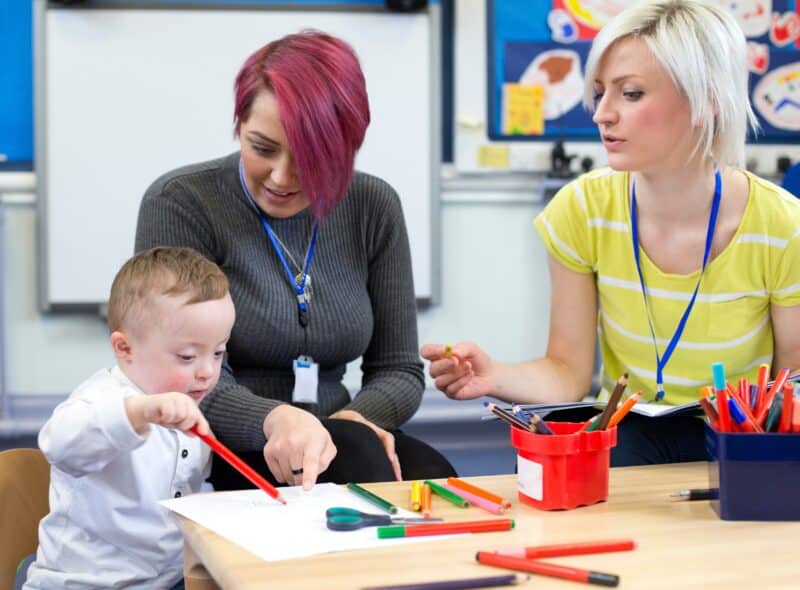 Speech-language impairments are the second most common disability type among all American students, and the most prevalent among preschool students. This demand puts immense pressure on providers: School-based Speech-Language Pathologists (SLPs) report an average caseload of about 50 students, yet the median manageable caseload is closer to ∼40. With a quarter of SLPs citing staff shortages as the greatest barrier to managing their workload, the challenge is clear: demand is high, and SLPs are stretched. This requires school leaders to seek out more effective, integrated service models that move beyond traditional “pull-out” therapy. In this blog, we’ll discuss practical strategies for using interprofessional collaboration to improve student outcomes and caseload efficiency.
Speech-language impairments are the second most common disability type among all American students, and the most prevalent among preschool students. This demand puts immense pressure on providers: School-based Speech-Language Pathologists (SLPs) report an average caseload of about 50 students, yet the median manageable caseload is closer to ∼40. With a quarter of SLPs citing staff shortages as the greatest barrier to managing their workload, the challenge is clear: demand is high, and SLPs are stretched. This requires school leaders to seek out more effective, integrated service models that move beyond traditional “pull-out” therapy. In this blog, we’ll discuss practical strategies for using interprofessional collaboration to improve student outcomes and caseload efficiency.
A collaborative approach to school-based language intervention is an approach where the SLP works in genuine partnership with other school professionals (like classroom teachers, special education teachers, and literacy specialists), students, and families. The central idea is to embed language therapy directly into the academic and social context of the school day. This shift promotes the generalization of skills to real-world settings.
 This model is defined by shared responsibility, mutual expertise, and integrated service delivery. The SLP and the teacher share ownership of a student’s language and academic outcomes. The SLP contributes expertise in language development and intervention, while the teacher brings knowledge of curriculum and classroom management. This synergy ensures IEP goals, which are written collaboratively by the whole team, are educationally relevant and supported across all settings.
This model is defined by shared responsibility, mutual expertise, and integrated service delivery. The SLP and the teacher share ownership of a student’s language and academic outcomes. The SLP contributes expertise in language development and intervention, while the teacher brings knowledge of curriculum and classroom management. This synergy ensures IEP goals, which are written collaboratively by the whole team, are educationally relevant and supported across all settings.
This shared approach manifests through a few different models of integrated language service delivery, each requiring varying levels of collaboration and input from the classroom teacher:
Consultation: The SLP provides training, resources, and specific strategies to the teacher, who then implements them with the student throughout the day. This method is highly efficient and assists with wide-scale classroom generalization.
Example: A kindergarten teacher is struggling to get a student to use their new vocabulary words during circle time. The SLP provides a quick tip: use a small, clear container of plastic toys that only the target student can access when they use a sentence frame like, “I see the [animal] on the [color] block.” The teacher implements this immediately during centers, and the student’s expressive language use triples that morning.
Co-Teaching: 
Example: A third-grade class is working on summarizing nonfiction text about insects. The SLP and the general education teacher stand together: the teacher leads the reading, and the SLP steps in to explicitly teach the whole class how to use a graphic organizer to find the main idea and three supporting details. All students, including those with language impairments, immediately apply the visual organizer to their work.
Classroom-Based Intervention: The SLP provides targeted intervention to a small group of students (which may include students without speech and language goals) within the classroom setting. This method increases awareness of language needs and is ideal for early intervention for at-risk students.
Example: A self-contained classroom is struggling with social cues during shared play. The SLP “pushes in” during free time and runs a small group teaching the students how to make eye contact and take turns, using the classroom’s actual toys and environment. This ensures the social language skills are learned in the exact setting where they are needed most.
Taking an integrated, collaborative approach to language intervention offers powerful benefits for the school, the staff, and the students:
Universal Design for Learning (UDL) is the essential 
Effective collaboration between the SLP and teacher requires maximizing limited shared time. Use a shared IEP goal tracker (i.e. SEDS or shared Google Sheet) before any meeting to quickly align on student progress toward language objectives. By clearly defining the specific agenda for the brief huddle (e.g., “Reviewing generalization of narrative structure” vs. “Modifying the geometry lesson vocabulary”), teams can ensure even a 5-minute pre- or post-class huddle is highly productive and results in clear, actionable steps for both professionals.

To eliminate scheduling conflicts and reduce the burden of email tag, designate a single, predictable method for sharing feedback on student performance. This could be a specific shared notebook left on the student’s desk, a brief template on a shared cloud document, or a specific 30-second window during transition time. By agreeing on this “one-stop-shop,” both the teacher and the SLP know exactly when and where to provide updates, ensuring consistent data flow without constant interruption.
Focus collaboration time on creating materials that benefit both parties and require minimal individual effort after planning. A key strategy is for the SLP to help the teacher integrate language objectives into existing classroom routines or universal materials. For example, the team could jointly create a simple, reusable “Check for Understanding” language board that the teacher uses with the whole class, and the SLP uses in therapy. This ensures consistency and makes the language scaffolding a shared responsibility, reducing the preparation burden on both professionals.
Language Accelerator is the perfect tool to drive your shift toward a more collaborative and efficient service model. As a technology-based personalized language intervention, it equips both SLPs and classroom teachers with a single, unified platform to address the urgent need for language intervention at scale. By using an assessment-driven model, Language Accelerator creates a personalized learning path and automatically targets goals across six language domains: semantics, morphology, syntax, pragmatics, phonology, and symbolic representation, plus articulation. It also includes literacy-based activities, including wordless picture books, and benchmark assessments. Language Accelerator’s centralized data collection allows the teacher and SLP to access the same lesson progress, providing valuable, consistent insight for IEP goal development and progress monitoring with less workload.
Integrate Language Accelerator to boost collaboration and alignment toward student language goals – learn how!